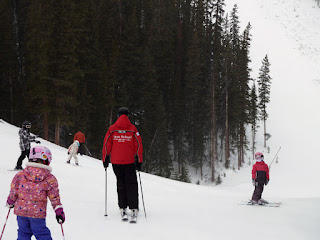MORE snow shoeing today, this time in Kananaskis Country.
I'm staying at the Delta Kananaskis Lodge, a hotel in what is essentially a purpose-built village designed to sit in the middle of a vast recreation area, and during the winter locals from around Alberta and even across the border in British Columbia head here to enjoy the snow.
There is a ski area called Naniska which was built to host the alpine events during the Calgary Winter Olympics back in 1988 as well as a huge belt of bush that's the perfect place to go snowshoeing, Nordic skiing and even dog sledding.
My guide Kristi and I drove for an hour to get to a remote trailhead where we parked the car, donned our warmest clothes, and headed out into a blizzard to explore more frozen lakes on foot.
The snow only fell for a few minutes and once we were clear of the car, and in a pasture of snow that was only marked with the occasional animal track, the sun came out with the pines laying long shadows on the white floor.
This part of Alberta, which is just a 90-minute drive from the boomtown city of Calgary, is completely uninhibited and so much snow falls here in the colder part of the year that the main road west is closed for months at a time.
"This used to be a huge coal mining area, and there are the remains of old mining and logging camps right through the Kananaskis Provincial Park," Kristi explained as we took a break to listen to the sounds of silence in the heart of the back country.
"There was even a prisoner-of-war camp out here during World War One and it was home to soldiers that came from Europe, and the prisoners were allowed to climb the mountains for exercise because there was nowhere for them to escape to.
"When the war ended many of them stayed here because they fell in love with the mountains, and they went on to provide the labour that built the hydro scheme up here."




















































